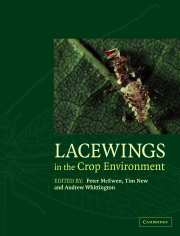Book contents
- Frontmatter
- Contents
- List of contributors
- Preface
- PART 1 Lacewing systematics and ecology
- PART 2 Lacewings in crops
- PART 3 Principles
- PART 4 Case studies
- Introduction to Part 4
- CHAPTER 18 Micromus tasmaniae: a key predator on aphids on field crops on Australasia?
- CHAPTER 19 Preliminary notes on Mallada signatus (Chrysopidae) as a predator in field crops in Australia
- CHAPTER 20 An evaluation of lacewing releases in North America
- CHAPTER 21 Chrysoperla externa and Ceraeochrysa spp.: potential for biological control in the New World tropics and subtropics
- CHAPTER 22 Comparative plant substrate specificity of Iberian Hemerobiidae, Coniopterygidae, and Chrysopidae
- CHAPTER 23 Lacewings in Sardinian olive groves
- CHAPTER 24 Lacewing occurrence in the agricultural landscape of Pianura Padana
- CHAPTER 25 Lacewings and snake-flies in Piedmont vineyards (northwestern Italy)
- CHAPTER 26 Control of aphids by Chrysoperla carnea on strawberry in Italy
- CHAPTER 27 Artificial overwintering chambers for Chrysoperla carnea and their application in pest control
- CHAPTER 28 Lacewings in Andalusian olive orchards
- CHAPTER 29 The green lacewings of Romania, their ecological patterns and occurrence in some agricultural crops
- CHAPTER 30 Biological control with Chrysoperla lucasina against Aphis fabae on artichoke in Brittany (France)
- PART 5 Conclusion
- Taxonomic index
- General index
CHAPTER 20 - An evaluation of lacewing releases in North America
Published online by Cambridge University Press: 04 May 2010
- Frontmatter
- Contents
- List of contributors
- Preface
- PART 1 Lacewing systematics and ecology
- PART 2 Lacewings in crops
- PART 3 Principles
- PART 4 Case studies
- Introduction to Part 4
- CHAPTER 18 Micromus tasmaniae: a key predator on aphids on field crops on Australasia?
- CHAPTER 19 Preliminary notes on Mallada signatus (Chrysopidae) as a predator in field crops in Australia
- CHAPTER 20 An evaluation of lacewing releases in North America
- CHAPTER 21 Chrysoperla externa and Ceraeochrysa spp.: potential for biological control in the New World tropics and subtropics
- CHAPTER 22 Comparative plant substrate specificity of Iberian Hemerobiidae, Coniopterygidae, and Chrysopidae
- CHAPTER 23 Lacewings in Sardinian olive groves
- CHAPTER 24 Lacewing occurrence in the agricultural landscape of Pianura Padana
- CHAPTER 25 Lacewings and snake-flies in Piedmont vineyards (northwestern Italy)
- CHAPTER 26 Control of aphids by Chrysoperla carnea on strawberry in Italy
- CHAPTER 27 Artificial overwintering chambers for Chrysoperla carnea and their application in pest control
- CHAPTER 28 Lacewings in Andalusian olive orchards
- CHAPTER 29 The green lacewings of Romania, their ecological patterns and occurrence in some agricultural crops
- CHAPTER 30 Biological control with Chrysoperla lucasina against Aphis fabae on artichoke in Brittany (France)
- PART 5 Conclusion
- Taxonomic index
- General index
Summary
INTRODUCTION
The study and use of green lacewings in North America has a long history that includes some of the initial research (1940s–70s) on lacewing augmentation, biology, field ecology, and mass-production techniques. Much of this early work helped develop guidelines for the commercial programmes that emerged in the 1980s. Nevertheless, research on the proper use and efficacy of augmentation programmes with lacewings lagged behind concurrent improvements in mass-production methods for parasitoids and increases in their commercial use, especially in glasshouse systems in Europe. During this past decade, research has once again focused on lacewing field ecology and augmentation and, as a result, there have been substantial advances in the use of Chrysoperla in North American agriculture. The progress includes (1) systematic revisions of green lacewings that make correct identification and evolutionarily based biological comparisons a reality, (2) improvements in the methodology for massproduction, (3) applying information from chemical ecology and seasonality to conserve and manipulate natural populations, and (4) rigorous experimental evaluation of release methodology and lacewing efficacy (see Tauber et al., 2000). In this chapter,we describe the advance from experimental to commercial use of lacewings and highlight three recent studies that improved consumer acceptance of the augmentation or conservation of lacewings by providing efficacy studies and setting commercial release guidelines.
EARLY USE OF LACEWINGS IN NORTH AMERICA
The first field releases of Chrysoperla carnea (Stephens) were made against the obscure mealybug, Pseudococcus viburni (Signoret), infesting California pears treated with DDT to control the codling moth, Cydia pomonella (L.).
- Type
- Chapter
- Information
- Lacewings in the Crop Environment , pp. 398 - 407Publisher: Cambridge University PressPrint publication year: 2001
- 3
- Cited by



